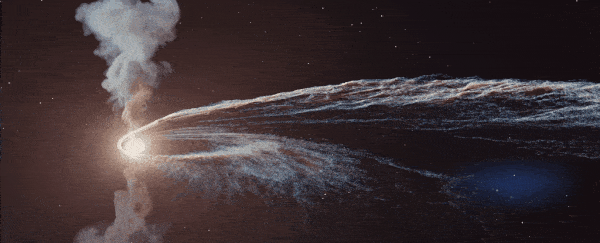A spectacularly brilliant flare of light from over 700 million light-years away is turning out to be a gift that keeps on giving.
Emitted from the heart of a galaxy, it was the dying electromagnetic scream of a star as it was torn apart and partially devoured by a black hole roughly 5 million times the mass of the Sun – and a new analysis has shown that it underwent the rather aptly named process of 'spaghettification' as it died.
Stellar deaths are usually violent affairs, but death by spaghettification is perhaps the most violent of them all. It occurs when a star wanders a little too close to a black hole, and the tidal force of its gravitational field pulls and tugs the star so hard that it ends up being torn apart – an event rather politely known as a tidal disruption event.
As the star is torn apart, some of the resulting debris 'spaghettifies' – attenuating into a long, thin thread of material a bit like a spaghetti noodle that spools into a thin filament that wraps around and feeds into the black hole.
We can detect this process because it lets out a brilliant flare of light produced by gravitational and frictional influences in the accretion disk around the black hole. This light gradually fades as the material is depleted.
Just such an event was detected in April 2019, picked up by the Zwicky Transient Facility, which surveys the skies looking for transient events. The event in question, later named AT2019dsg, was unusually bright even for a tidal disruption event, flaring across the X-ray, ultraviolet, optical, and radio wavelengths.
The inner edge of the accretion disk closest to the black hole is the hottest part of the disk and therefore emits the most energetic radiation, the X-rays. That we can detect X-rays at all means that we are staring down the pole of the supermassive black hole – otherwise, it would be obscured by the outer regions of the accretion disk.
Think of looking at a donut side-on. You can't see the hole, can you?
We've seen X-radiation in tidal disruption events before, of course, but there was something very different about AT2019dsg. An international team of astronomers led by Giacomo Cannizzaro and Peter Jonker of the Netherlands Institute for Space Research examined the electromagnetic output and discovered absorption lines.
Absorption lines are great, by the way. When astronomers take images of light, if that light has traveled through something that slows or blocks some wavelengths, such as gas or dust, that will show up as dark lines on the spectrum.
They show up in all sorts of places, but the poles of supermassive black holes are not usually among them. Accretion disks usually orbit the equatorial region – you know, like Saturn's rings – and straight down the pole is usually fairly clear.
The variation and the width of these absorption lines were weird too. The observed configuration seemed to suggest multiple strands of material, like a ball of string.
This, in turn, suggested that there was something wrapped around the black hole at an unusual angle, such as the spaghettified filaments of a tidally disrupted star, perhaps, flung out away from the bulk of the stellar debris.
"When a star is disrupted, the debris may form strongly self-gravitating streams," the researchers wrote in their paper.
"What we could be seeing is absorption lines caused by such streams, where the different orbital motions and projected velocities of these different streams cause the variation of the width of the lines.
"To have this, we would need some of the self-gravitating streams to be deflected by large angles, while the bulk of the disrupted material circularizes into an accretion disk."
If the team's interpretation of spaghettification turns out to be correct, it would be the first time we have had actual direct evidence of this process occurring.
AT2019dsg has come to our attention before, when scientists detected what seemed to be a high-energy neutrino spat out by the event. One has to wonder what other surprises this unusually bright star death has in store.
The research has been published in the Monthly Notices of the Royal Astronomical Society.
